 I am pleased to welcome back the 2nd Folio of Shakespeare, just in time for the fall semester!
I am pleased to welcome back the 2nd Folio of Shakespeare, just in time for the fall semester!
Acquired by the Watkinson in the spring of 2012, the book was cleaned and repaired in February by Marie Oedel, who does conservation work for the Museum of Fine Arts in Boston (among other places). Marie generously donated about 30% of the labor involved–which came to over 40 hours of cleaning and repairing!
We then had to replace seven (7) missing leaves from the book, which were reproduced lettepress (from polymer plates) by Scott Vile of the Ascensius Press from scans of the copy at the John Carter Brown Library (Brown University).
Finally, we had the book bound in full leather by Sam Ellenport, a master binder, who used materials and designs consistent with books bound in England in the 1630s.
It is now ready to take up permanent residence in the Watkinson stacks, and to be shown to classes and consulted by researchers!
Comments Off on 2nd Folio in a new dress, ready to party!
 On Wednesday (the eve of Shakespeare’s birthday) the Watkinson (producer) paired up with volunteers from Dan Lloyd’s “Shakespeare as Philosopher” class (cast) and area teaching artist Christin Goff (Director) to perform a staged reading of King John.
On Wednesday (the eve of Shakespeare’s birthday) the Watkinson (producer) paired up with volunteers from Dan Lloyd’s “Shakespeare as Philosopher” class (cast) and area teaching artist Christin Goff (Director) to perform a staged reading of King John.
 The players performed to a small but dedicated audience–augmented by a few floaters after intermission, who doubtless came to see what all the fuss was about. The production was augmented by inter-scene and intermission music, live bongo drums (for dramatic affect), and projected slides which provided a visual gloss, of sorts, to the action, which at times can be unclear (this is not one of the more well-known plays). However, the text was edited by Ms. Goff for the performance, which helped the flow and pacing of the play, and the name-cards displayed when a character was speaking also helped.
The players performed to a small but dedicated audience–augmented by a few floaters after intermission, who doubtless came to see what all the fuss was about. The production was augmented by inter-scene and intermission music, live bongo drums (for dramatic affect), and projected slides which provided a visual gloss, of sorts, to the action, which at times can be unclear (this is not one of the more well-known plays). However, the text was edited by Ms. Goff for the performance, which helped the flow and pacing of the play, and the name-cards displayed when a character was speaking also helped.
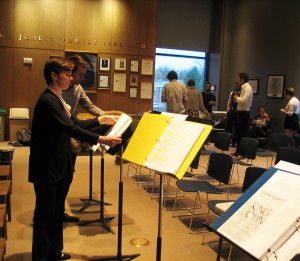
 This was the first in what we plan will be a series of productions of Shakespeare sponsored by the Watkinson, to draw attention to the recently acquired and restored “2nd Folio” (the second edition of the first publication of the complete plays of Shakespeare, printed in 1632).
This was the first in what we plan will be a series of productions of Shakespeare sponsored by the Watkinson, to draw attention to the recently acquired and restored “2nd Folio” (the second edition of the first publication of the complete plays of Shakespeare, printed in 1632).
We thank professor Lloyd & his class for their hard work!

Comments Off on King John in the Library
 This evening is the first meeting of players from prof. Dan Lloyd’s “Shakespeare as Philosopher” (PHIL 254) class who have agreed to participate in a staged reading of The Life and Death of King John, a play not often performed in modern times.
This evening is the first meeting of players from prof. Dan Lloyd’s “Shakespeare as Philosopher” (PHIL 254) class who have agreed to participate in a staged reading of The Life and Death of King John, a play not often performed in modern times.
 We are sponsoring this performance for two reasons: to herald the acquisition (in spring 2012) and restoration (in spring 2015) of the so-called “2nd Folio” of Shakespeare; and also to herald our fall exhibition honoring the 800th anniversary of Magna Carta, which King John put his royal seal to in 1215, and to which Connecticut can honorably trace its constitutionalism.
We are sponsoring this performance for two reasons: to herald the acquisition (in spring 2012) and restoration (in spring 2015) of the so-called “2nd Folio” of Shakespeare; and also to herald our fall exhibition honoring the 800th anniversary of Magna Carta, which King John put his royal seal to in 1215, and to which Connecticut can honorably trace its constitutionalism.
The PERFORMANCE will be on April 22, at 7:00pm in the Joslin Family 1823 Room.
Comments Off on Staged reading of King John
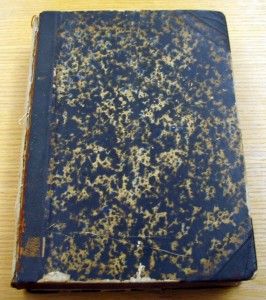 As many of our readers know we acquired a “2nd Folio” of Shakespeare in 2012–the second edition (1632) of the first complete collection of the Bard’s plays ever printed (the first was in 1623). This copy resided in the possession of one family for generations–back to the mid-19th century, in fact–and although they took care of it, nothing in the way of conservation has been done to the book in over 150 years.
As many of our readers know we acquired a “2nd Folio” of Shakespeare in 2012–the second edition (1632) of the first complete collection of the Bard’s plays ever printed (the first was in 1623). This copy resided in the possession of one family for generations–back to the mid-19th century, in fact–and although they took care of it, nothing in the way of conservation has been done to the book in over 150 years.
The 19thC binding is falling apart, the sewing is coming undone, there are water stains, inactive mold, paint and ink marks, food remains, and just a general level of grime present all through the book. Every page must be cleaned with brushes and dry-cleaning erasers, tears in the pages mended with Japanese paper, older (and clumsier) repairs must be fixed or undone and re-done, and fragile edges reinforced so that the binder can put it all back together (including facsimiles of the seven missing leaves).
We have selected Marie Oedel as our conservator–who serves in that capacity to the Boston Museum of Fine Arts Library (please see her website for her many credentials). Our binder is Sam Ellenport, a master of his craft who ran the Harcourt Bindery in Boston for 40 years.
Our goal is to raise $5,000 for this project–please e-mail richard.ring@trincoll.edu if you would like to help!
Here are some pics of water damage, mold, and tears present in the book:
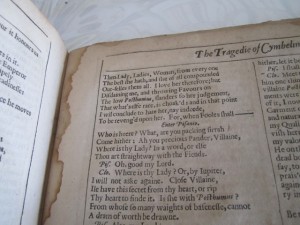
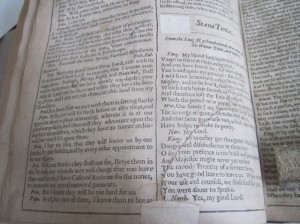

Comments Off on Help us restore the Bard!
 If the Shakespeare world of the nineteenth century would seem at times to have been more than usually populated with brilliant rogues and charming rascals, it also had its less colorful and more sober-minded scholars. Chief among these were the editors of the Cambridge Shakespeare, who issued their enormously influential nine-volume text between 1863 and 1866.
If the Shakespeare world of the nineteenth century would seem at times to have been more than usually populated with brilliant rogues and charming rascals, it also had its less colorful and more sober-minded scholars. Chief among these were the editors of the Cambridge Shakespeare, who issued their enormously influential nine-volume text between 1863 and 1866.

Andrew Murphy, Shakespeare in Print (Cambridge UP, 2003)
Comments Off on The Bard in the Watkinson (16): the Cambridge Shakespeare of 1863-66
 In 1880, F. J. Furnivall began issuing photolithographic facsimiles of the quartos, with the texts being created by William Griggs and Charles Praetorius, which was apparently not a happy collaboration. While it provided facsimiles for students with scholarly introductions, it came under criticism a few decades later from the bibliographer W. W. Greg.
In 1880, F. J. Furnivall began issuing photolithographic facsimiles of the quartos, with the texts being created by William Griggs and Charles Praetorius, which was apparently not a happy collaboration. While it provided facsimiles for students with scholarly introductions, it came under criticism a few decades later from the bibliographer W. W. Greg.
Andrew Murphy, Shakespeare in Print (Cambridge UP, 2003)
Comments Off on The Bard in the Watkinson (17): the Furnivall set of Quarto facsimiles
 Between 1853 and 1865 James Orchard Halliwell produced one of the most lavish editions of the nineteenth century, in sixteen extensively illustrated folio volumes, with woodcuts by F. W. Fairholt. The edition was strictly limited and very expensive.
Between 1853 and 1865 James Orchard Halliwell produced one of the most lavish editions of the nineteenth century, in sixteen extensively illustrated folio volumes, with woodcuts by F. W. Fairholt. The edition was strictly limited and very expensive.
According to the Edinburgh Review, “Mr. Halliwell’s magnificent folios, which rejoice the eye . . . afford no solace whatever to the mind.”
A total of 150 copies were produced for subscribers, after which the ‘blocks and plates of the numerous woodcuts , facsimiles, and engravings used’ were destroyed.
In 25 copies the plates were reproduced on India paper (the cost of these copies was 150 guineas). For regular copies, the subscription price was 80 guineas.
Halliwell, who co-founded the Shakespeare Society with John Payne Collier (Shakespearean critic, editor, and forger) and others, had a rather shady past. Granted access to the manuscript collections of Trinity College (Cambridge), he stole some materials from the library and sold them to the British Museum! He managed to weather that storm (the two institutions failed to agree on terms regarding legal action), and became friendly with Sir Thomas Phillipps, the wealthy antiquarian and collector. After gaining access to the library, Halliwell also sought Phillipps’ daughter in marriage, which enraged the father and led to a schism, but the couple inherited the Phillipps fortune after his death in 1867.
Andrew Murphy, Shakespeare in Print (Cambridge UP, 2003)
Comments Off on The Bard in the Watkinson (15): The Halliwell-Phillipps edition of 1853-65
 In 1792 the comparatively unsuccessful Shakespearean Joseph Ritson had launched a direct assault on Edmund Malone’s 1790 edition, claiming that he wished “to rescue the language and sense” of Shakespeare “from the barbarism and corruption they have acquired in passing through the hands of this incompetent and unworthy editor,” and caricatured Malone as a “Paddy from Cork” Irishman.
In 1792 the comparatively unsuccessful Shakespearean Joseph Ritson had launched a direct assault on Edmund Malone’s 1790 edition, claiming that he wished “to rescue the language and sense” of Shakespeare “from the barbarism and corruption they have acquired in passing through the hands of this incompetent and unworthy editor,” and caricatured Malone as a “Paddy from Cork” Irishman.
In 1792 Malone proposed “a new and splendid edition” in fifteen large volumes, but the publisher cancelled his contract due to slow sales.
Although we LACK the 1790 edition, we have the Malone-James Boswell edition of 1821, which was the final realization of Malone’s vision of 1792.
Andrew Murphy, Shakespeare in Print (Cambridge UP, 2003)
Comments Off on The Bard in the Watkinson (14): Edmund Malone’s edition
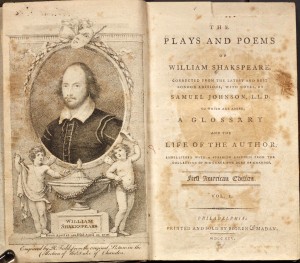 Literary historian George Churchill, writing in 1906, observed (with a typically imperialist tone) that a “people that is winning the soil out of the wilderness and defending itself against savages has no thought of literature, much less of stage-plays,” and further noted that “Massachusetts was a Puritan state, founded by the kin of those of those men who in England attacked so bitterly the stage of Shakespeare. Pennsylvania was a Quaker colony, and the serious views of the Quaker gave no more countenance to the drama than did the austere and ascetic Calvinism of the Puritan.”
Literary historian George Churchill, writing in 1906, observed (with a typically imperialist tone) that a “people that is winning the soil out of the wilderness and defending itself against savages has no thought of literature, much less of stage-plays,” and further noted that “Massachusetts was a Puritan state, founded by the kin of those of those men who in England attacked so bitterly the stage of Shakespeare. Pennsylvania was a Quaker colony, and the serious views of the Quaker gave no more countenance to the drama than did the austere and ascetic Calvinism of the Puritan.”
Records indicate that among the first copies of Shakespeare in America were ones bought by New England Courant Editor James Franklin (in 1722), Harvard (in 1723, which had purchased Rowe’s 1709 edition), Yale (which listed an edition in the 1743 library catalogue), and in 1746 by the Library Company of Philadelphia (the Hanmer edition).
The 1795 Philadelphia complete works, which we have in the Watkinson, was the first edition of Shakespeare to be produced outside of Great Britain. Alfred Van Rensselaer Westfall has tentatively identified the editor as Joseph Hopkinson, a prominent Philadelphia lawyer, observing that his work on the edition “leaves little to his credit,” as he hardly did more than “hand the printer a glossary from one edition, the text from a second, and a few notes from a third.” Interestingly, the bulk of the preface is taken up with a defense of Shakespeare’s works against the charge of immorality.
Andrew Murphy, Shakespeare in Print (Cambridge UP, 2003)
Comments Off on The Bard in the Watkinson (13): First American edition
 One of the big gaps in our collection is the first edition of Samuel Johnson’s text of Shakespeare, published in London in 1765 (8 volumes), and followed immediately that same year with a second edition. The third edition was published in 1768 in London (10 volumes).
One of the big gaps in our collection is the first edition of Samuel Johnson’s text of Shakespeare, published in London in 1765 (8 volumes), and followed immediately that same year with a second edition. The third edition was published in 1768 in London (10 volumes).
We ALSO LACK the “Johnson-Steevens” edition published in London, 1773 (10 volumes), and the Johnson-Steevens-Reed editions of 1778 (London, 10 vols.) and 1785 (Dublin, 10 vols.).
We do, however, have the 1793 Johnson-Steevens-Reed edition, which is the earliest version of Johnson’s Shakespeare we have in the Watkinson. Perhaps some generous alum has a copy of the 1765 edition? We would love to own it!
In 1783, Steevens wrote to Reed, asking him to assume control of the next planned revision of the text, and provided Reed with “some 445 additions, revisions, and omissions in his own 1773 notes.” Johnson himself died in 1784, but his name continued to appear on the title-pages of the Steevens-Reed sequence. Though he had handed control of the text to Reed for the 1785 edition, Steevens resumed control for this edition of 1793, using it as a platform to attack fellow Shakespearean Edmond Malone through his proxy Joseph Ritson, who in 1792 launched a direct assault on Malone, claiming that he wished “to rescue the language and sense” of Shakespeare “from the barbarism and corruption they have acquired in passing through the hands of this incompetent and unworthy editor,” and caricatured Malone as a “Paddy form Cork” Irishman.
Andrew Murphy, Shakespeare in Print (Cambridge UP, 2003)
Comments Off on The Bard in the Watkinson (12): Johnson-Steevens-Reed edition
 On Wednesday (the eve of Shakespeare’s birthday) the Watkinson (producer) paired up with volunteers from Dan Lloyd’s “Shakespeare as Philosopher” class (cast) and area teaching artist Christin Goff (Director) to perform a staged reading of King John.
On Wednesday (the eve of Shakespeare’s birthday) the Watkinson (producer) paired up with volunteers from Dan Lloyd’s “Shakespeare as Philosopher” class (cast) and area teaching artist Christin Goff (Director) to perform a staged reading of King John. The players performed to a small but dedicated audience–augmented by a few floaters after intermission, who doubtless came to see what all the fuss was about. The production was augmented by inter-scene and intermission music, live bongo drums (for dramatic affect), and projected slides which provided a visual gloss, of sorts, to the action, which at times can be unclear (this is not one of the more well-known plays). However, the text was edited by Ms. Goff for the performance, which helped the flow and pacing of the play, and the name-cards displayed when a character was speaking also helped.
The players performed to a small but dedicated audience–augmented by a few floaters after intermission, who doubtless came to see what all the fuss was about. The production was augmented by inter-scene and intermission music, live bongo drums (for dramatic affect), and projected slides which provided a visual gloss, of sorts, to the action, which at times can be unclear (this is not one of the more well-known plays). However, the text was edited by Ms. Goff for the performance, which helped the flow and pacing of the play, and the name-cards displayed when a character was speaking also helped.
 This was the first in what we plan will be a series of productions of Shakespeare sponsored by the Watkinson, to draw attention to the recently acquired and restored “2nd Folio” (the second edition of the first publication of the complete plays of Shakespeare, printed in 1632).
This was the first in what we plan will be a series of productions of Shakespeare sponsored by the Watkinson, to draw attention to the recently acquired and restored “2nd Folio” (the second edition of the first publication of the complete plays of Shakespeare, printed in 1632).














